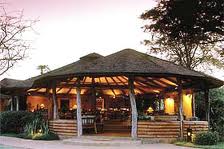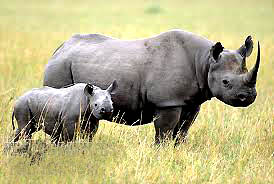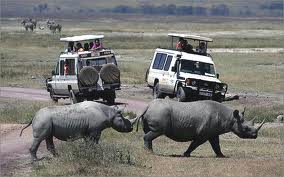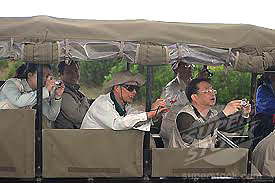Kenya might make 20 times more money from the Masai Mara Game Reserve, which is just a sixth of Tanzania’s Serengeti, but this, reports Special Correspondent WYCLIFFE MUGA, comes at a huge environmental cost .
By Wycliffe Muga
PERC Media Fellow

According to Mr Jochen Zeitz, Founder of the Zeitz Foundation, Chairman and CEO of PUMA, “The GER stamp of approval means that these two amazing places tick all the right boxes in the areas of Conservation, Community, Culture and Commerce.This endorsement is unique in that it prizes the resorts’ efforts across the board, thereby establishing them as leaders in the field of sustainable tourism”.
Zeitz is best known in Kenya as the man who brought two of the world’s most celebrated sportsmen to the country. First there was Samuel Eto, the Cameroonian football star who turns out for Italian football club Internazionale but is most remembered for his many years at the leading Spanish club FC Barcelona.
And then there was the fastest man in the world, Usain Bolt of Jamaica, who came to Kenya for the official launch of the Zeitz Foundation. This announcement comes at a time when there is debate about the future of the jewel in the crown of Kenya’s tourism: the Masai Mara Game Reserve, host to the Seventh Wonder of the World, the annual Great Migration of wildebeest and other plains animals.

SURVIVE
Equally unusual is that whereas the Transmara portion of the reserve is managed through a Public-Private-Partnership between the Transmara Council and the Mara Conservancy, the Narok portion is still managed directly by the Narok County Council.
Because of its global reputation, the Masai Mara has been subjected to the most intense ‘development pressure’ of all the Kenyan game parks, with tour operators lining up in wait for any new investment opportunities that might arise.
But environmental scientists have long argued that the Mara is already overdeveloped and that any new lodges or camps should properly be located in conservancies well outside the park’s official boundaries and in the wildlife dispersal areas which are mostly group ranches owned by the local Maasai communities.
Debate has centred on whether the Mara-Serengeti ecosystem — of which the Maasai Mara is a part — can possibly survive the impact of having so many lodges and camps established within it, and so many tour vans racing through it.
And doubts have also been expressed about whether the local Maasai, whose group ranches make up the crucial dispersal areas around the game reserve, have really benefited adequately from the presence of so many wild animals on what is, after all, privately owned land.
For while some of the Maasai clans have entered into lucrative long-term lease arrangements with tour operators to create private conservancies on their group ranches, there are still many who have yet to organise their groups for this purpose, and so effectively gain nothing from the presence of these wild animals on their land.
So here is a situation in which the economic interests of the Maasai clans and culture and the need for more investment in Kenya’s vital tourism industry as well as the need to preserve the Masai Mara for posterity all have to be reconciled.
Further complicating the picture is that Kenya and Tanzania have for some years now had markedly different policies when it comes to the development of tourism facilities in this jointly owned environmental asset.
The Serengeti — along with the Masai Mara Game Reserve in Kenya — forms part of a continuing grasslands ecosystem that has been made famous by the annual wildebeest migrations that involve about a million-and-a-half animals crossing the Mara River from the Serengeti plains to enter the Masai Mara.
But a look at the comparative revenues from this great wildlife spectacle tells a strange story:
The Masai Mara is only about one-sixth the size of the Serengeti, and the vast wildebeest herds only spend two months of the year there, before returning to the Serengeti plains. Yet Kenya collects 20 times as much as Tanzania does, from this jointly-owned tourist attraction. And the reason for this is that the Kenyan side has superior infrastructure — a better network of roads, airstrips, and so on — that supports far more hotels and lodges than are to be found in the Serengeti.
But Kenya’s much greater revenues have come at a steep price: in early 2010, there was much controversy over a proposed new luxury camp, which was being built on a forested section of the banks of the Mara River.

However in the end the developers had their way; the beautiful new camp was built and — as the environmentalists had predicted — the black rhinos all crossed the invisible line known as the ‘national boundary’ that separates Kenya and Tanzania, and are now to be found in the Serengeti.
As rhinos are by far the rarest of the Big Five (the others are lions, elephants, buffalo, and leopard) of the charismatic mega-fauna which the African safari experience is built around, this was a great loss indeed.

And that whereas Tanzania may not get as much money as Kenya does, in most respects its conservation policies guarantee greater sustainability.
INIMICAL
It is in this context that the Zeitz Foundation’s innovative certification programme has enormous significance, as it offers clear guidelines on how globally recognised standards in sustainability may be attained.
Dr Liz Rihoy, the Director of the Zeitz Foundation, explained: “The ZF approach to sustainability is encapsulated in our ‘4 Cs’ philosophy. We believe that a careful balance needs to be struck between activities encompassing conservation, community development, culture and commerce.
Eco-tourism, which is popular in Kenya, would be a stronger tool for promoting sustainable approaches if it provided equal emphasis to promoting community development, commercial viability and provision of platforms to promote positive cultural exchanges and cultural understanding, along with its current emphasis on conservation.” Rihoy further elaborated, “Our certification process provides a rigorous framework that enables external assessment to be made regarding activities within these four areas. These assessments are undertaken and evaluated by a team of experts, the Foundation’s specialists, who are leading global experts in their respective fields”.
This GER Certification is setting a new standard in sustainability and is a driving force in promoting and developing sustainable thinking around the globe. It ensures that best practices in sustainability are adhered to and innovative approaches experimented with and researched to develop sustainable solutions.
“During the certification process, the assessors met with various members of the community to evaluate our relationship with them,” notes Mr Carlos Rojas Jara, Co-Founder of Monte Azul. “This was unexpected and highlights the commitment to quality, integrity and the thoroughness of the Zeitz Foundation’s certification programme, of which we are honoured to be the first to receive the GER certificate.”
Monte Azul is a centre for contemporary art and conservation and hotel project located in the rainforest-covered mountains of southern Costa Rica. It is the product of the founders’ passion for art and design, and their commitment to social and environmental awareness.
Chumbe Island Coral Park is the first privately-managed marine protected area in the world. “In working towards this certification, we have shared and discussed achievements and lessons learned in the long Chumbe history, and our efforts to promote marine conservation in Tanzania, and to set an example for genuine eco-tourism and environmental education, all this in a challenging environment,” says Ms Sibylle Riedmiller, Founder of Chumbe
Zeitz is best known in Kenya as the man who brought two of the world’s most celebrated sportsmen to the country. First there was Samuel Eto, the Cameroonian football star who turns out for Italian football club Internazionale but is most remembered for his many years at the leading Spanish club FC Barcelona.
And then there was the fastest man in the world, Usain Bolt of Jamaica, who came to Kenya for the official launch of the Zeitz Foundation. This announcement comes at a time when there is debate about the future of the jewel in the crown of Kenya’s tourism: the Masai Mara Game Reserve, host to the Seventh Wonder of the World, the annual Great Migration of wildebeest and other plains animals.
The Mara has the odd distinction of being at once a resource of the Narok and Transmara county councils (which share the revenues from the gate collections for this world-famous game park) and also being a national asset because the animals within the park do not belong to these civic entities. They are under the guardianship of the Kenya Wildlife Service (KWS) on behalf of all Kenyans.
SURVIVE
Equally unusual is that whereas the Transmara portion of the reserve is managed through a Public-Private-Partnership between the Transmara Council and the Mara Conservancy, the Narok portion is still managed directly by the Narok County Council.
Because of its global reputation, the Masai Mara has been subjected to the most intense ‘development pressure’ of all the Kenyan game parks, with tour operators lining up in wait for any new investment opportunities that might arise.
But environmental scientists have long argued that the Mara is already overdeveloped and that any new lodges or camps should properly be located in conservancies well outside the park’s official boundaries and in the wildlife dispersal areas which are mostly group ranches owned by the local Maasai communities.
Debate has centred on whether the Mara-Serengeti ecosystem — of which the Maasai Mara is a part — can possibly survive the impact of having so many lodges and camps established within it, and so many tour vans racing through it.
And doubts have also been expressed about whether the local Maasai, whose group ranches make up the crucial dispersal areas around the game reserve, have really benefited adequately from the presence of so many wild animals on what is, after all, privately owned land.

So here is a situation in which the economic interests of the Maasai clans and culture and the need for more investment in Kenya’s vital tourism industry as well as the need to preserve the Masai Mara for posterity all have to be reconciled.
Further complicating the picture is that Kenya and Tanzania have for some years now had markedly different policies when it comes to the development of tourism facilities in this jointly owned environmental asset.
The Serengeti — along with the Masai Mara Game Reserve in Kenya — forms part of a continuing grasslands ecosystem that has been made famous by the annual wildebeest migrations that involve about a million-and-a-half animals crossing the Mara River from the Serengeti plains to enter the Masai Mara.
But a look at the comparative revenues from this great wildlife spectacle tells a strange story:
The Masai Mara is only about one-sixth the size of the Serengeti, and the vast wildebeest herds only spend two months of the year there, before returning to the Serengeti plains. Yet Kenya collects 20 times as much as Tanzania does, from this jointly-owned tourist attraction. And the reason for this is that the Kenyan side has superior infrastructure — a better network of roads, airstrips, and so on — that supports far more hotels and lodges than are to be found in the Serengeti.
But Kenya’s much greater revenues have come at a steep price: in early 2010, there was much controversy over a proposed new luxury camp, which was being built on a forested section of the banks of the Mara River.
The environmentalists, who opposed this new development, argued that this riverine habitat was a breeding ground for the black rhino. And as rhino populations in Kenya had fallen drastically due to poaching, the black rhinos in the Masai Mara were among the few free-ranging rhino populations to be found in Kenya.
However in the end the developers had their way; the beautiful new camp was built and — as the environmentalists had predicted — the black rhinos all crossed the invisible line known as the ‘national boundary’ that separates Kenya and Tanzania, and are now to be found in the Serengeti.
As rhinos are by far the rarest of the Big Five (the others are lions, elephants, buffalo, and leopard) of the charismatic mega-fauna which the African safari experience is built around, this was a great loss indeed.
By voting with their hooves, the rhinos demonstrated that although Kenya may for the time being reap far greater revenues from its tourism, its environmental policies are in the long run inimical to the survival of the very wildlife which is the key to Kenya’s tourism sector.
And that whereas Tanzania may not get as much money as Kenya does, in most respects its conservation policies guarantee greater sustainability.
INIMICAL
It is in this context that the Zeitz Foundation’s innovative certification programme has enormous significance, as it offers clear guidelines on how globally recognised standards in sustainability may be attained.
Dr Liz Rihoy, the Director of the Zeitz Foundation, explained: “The ZF approach to sustainability is encapsulated in our ‘4 Cs’ philosophy. We believe that a careful balance needs to be struck between activities encompassing conservation, community development, culture and commerce.
Eco-tourism, which is popular in Kenya, would be a stronger tool for promoting sustainable approaches if it provided equal emphasis to promoting community development, commercial viability and provision of platforms to promote positive cultural exchanges and cultural understanding, along with its current emphasis on conservation.” Rihoy further elaborated, “Our certification process provides a rigorous framework that enables external assessment to be made regarding activities within these four areas. These assessments are undertaken and evaluated by a team of experts, the Foundation’s specialists, who are leading global experts in their respective fields”.
This GER Certification is setting a new standard in sustainability and is a driving force in promoting and developing sustainable thinking around the globe. It ensures that best practices in sustainability are adhered to and innovative approaches experimented with and researched to develop sustainable solutions.
“During the certification process, the assessors met with various members of the community to evaluate our relationship with them,” notes Mr Carlos Rojas Jara, Co-Founder of Monte Azul. “This was unexpected and highlights the commitment to quality, integrity and the thoroughness of the Zeitz Foundation’s certification programme, of which we are honoured to be the first to receive the GER certificate.”
Monte Azul is a centre for contemporary art and conservation and hotel project located in the rainforest-covered mountains of southern Costa Rica. It is the product of the founders’ passion for art and design, and their commitment to social and environmental awareness.
Chumbe Island Coral Park is the first privately-managed marine protected area in the world. “In working towards this certification, we have shared and discussed achievements and lessons learned in the long Chumbe history, and our efforts to promote marine conservation in Tanzania, and to set an example for genuine eco-tourism and environmental education, all this in a challenging environment,” says Ms Sibylle Riedmiller, Founder of Chumbe



